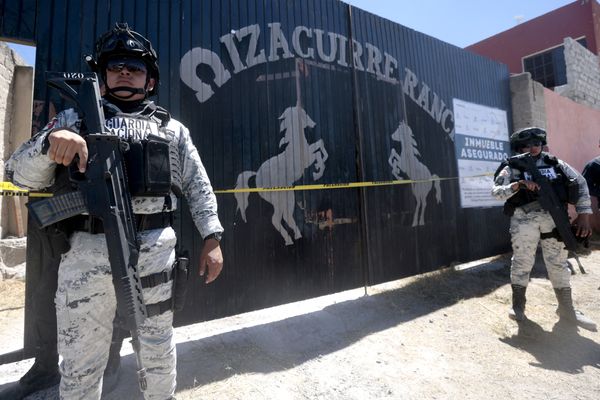
When war broke out in 1939, the British government was faced with a giant and immediate problem: what to do with the 73,000 Germans and Austrians living in Britain who had become “enemy aliens” overnight. The answer was mass internment, a policy authorised by Churchill days after he took office as prime minister in May 1940. Police around the country were dispatched to arrest male nationals of axis powers – which would soon include Italy – aged between 16 and 60 and cart them off to prison. Some of these internees would be sent on perilous voyages to Canada and Australia, but the majority were taken to camps on the Isle of Man. One of these, Hutchinson camp, is the subject of Simon Parkin’s excellent new book.
The policy of detaining civilians en masse without trial represents a dark chapter in Britain’s war. It grew out of the fear, stoked by the press, that “fifth columnists” had been sent to infiltrate the country and undermine British defences against the coming German invasion. Churchill realised as early as August that the threat was exaggerated, but by this time the arrests had been made, and many of the internees, who included women and children, would not be released for years. The most shameful aspect of internment was that it predominantly picked up Jewish refugees who had fled to Britain to escape the terror visited on them by Hitler’s stormtroopers.
Parkin builds his narrative around the artist Peter Midgley, born Peter Fleischmann, a Jewish-German orphan who was just young enough to qualify for the Kindertransport and just old enough to be caught in the internment dragnet. In December 1938, SS officers stole from Midgley and the other children as their refugee train left Germany. Eighteen months later, in 1940, Midgley watched refugees being robbed again, this time by British soldiers at the corrupt and dysfunctional Warth Mills internment camp in Lancashire. The intentions of the British and German governments towards the Jews were very different, but the irony of their treatment in the country where they had sought asylum was not lost on the refugees. Hitler would gloat that year: “The British have detained in concentration camps the very people we found it necessary to detain.”
There was a silver lining for some, however, as Midgley realised when he reached Hutchinson camp in Douglas that August. The camp consisted of a few fenced-off streets of requisitioned boarding houses, set around a lawned square, a hundred yards from the beach. Here, the Home Office inadvertently gathered the gold-top milk of artistic talent: film-makers and actors, musicians and fashion designers, architects and scientists, painters, sculptors and writers. As Parkin puts it: “It was as if a tsunami had deposited a crowd of Europe’s prominent men on to this obscure patch of grass in the middle of the Irish Sea.” The prisoners were placed under the benign care of Captain Hubert Daniel, a Mainwaring-esque former Lever Brothers ad man, and together they turned Hutchinson into a surreal artists’ retreat, more dadaist Hi-de-Hi! than Stalag Luft III.
Dr Klaus Hinrichsen, an interned art historian, caught wind of the camp’s intellectual nature the day after his arrival, when he saw a group of men carrying chairs from one of the houses. Each chose a spot on the lawn a little away from the others, plonked the chair down, then stood on it and began to lecture on his specialist subject – Greek philosophy, Shakespeare’s sonnets, the industrial use of synthetic fibres – as an audience of internees gathered. The camp was packed with distinguished professors and experts, and they were determined to continue their trade whatever the British government might do. Hinrichsen and his housemate, the architect Bruno Ahrends, would develop these impromptu lectures into a busy cultural programme, delivered by a “cultural department” and approved by Captain Daniel. Soon there was a “Hutchinson University”, complete with a librarian. Later there would be piano recitals, theatre productions, art exhibitions, a vibrant newspaper, an artists’ cafe run by a Viennese patissier, and a “technical school” teaching engineering skills.
The internees arrived at Hutchinson stressed and sometimes suicidal, but in the camp’s rarefied environment, with their basic needs catered for and few distractions, they began to thrive. The most famous Hutchinson resident was Kurt Schwitters, the Hanover-born artist whose work was defamed in Goebbels’s infamous “degenerate art” shows. His escape from Germany left Schwitters traumatised and epileptic, but Hutchinson restored him, and his time here comprised one of his most productive periods. He took the resourceful Midgley on as an assistant, honing his natural ability, so that when the young man was released he won a place at art school. He would later become a Royal Academician, and maintain for the rest of his life that “all the good things that have happened to me, happened as a result of my being there”, at Hutchinson.

Even so, internment was a grim experience for most, and although Britain came to view it as an embarrassment, the government has never formally apologised. Lessons do not seem to have been learned. It is impossible to read this story and not think of the treatment of refugees who are crossing the Channel today. In a postscript, Parkin states that the UK subjects 24,000 people a year to immigration detention, half of whom are claiming refuge. Unlike in other European countries, there is no time limit on this form of custody. He also reminds us that in 2019 the Trump administration separated more than 2,000 migrant children from their parents at the Mexican border, and failed even to give them enough to eat.
Parkin has told his story with energy and flair. The book is not without minor flaws: the cast of characters is dizzyingly large, and at times the narrative is obscured by extraneous information, but these do not detract from Parkin’s achievement. The Island of Extraordinary Captives is a powerful tribute to the wartime internees, and a timely reminder of how much Britain gained from their presence.
• Charlie English is the author of The Gallery of Miracles and Madness, published by William Collins. The Island of Extraordinary Captives: A True Story of an Artist, a Spy and a Wartime Scandal by Simon Parkin is published by guardianbookshop.com. Delivery charges may apply.







